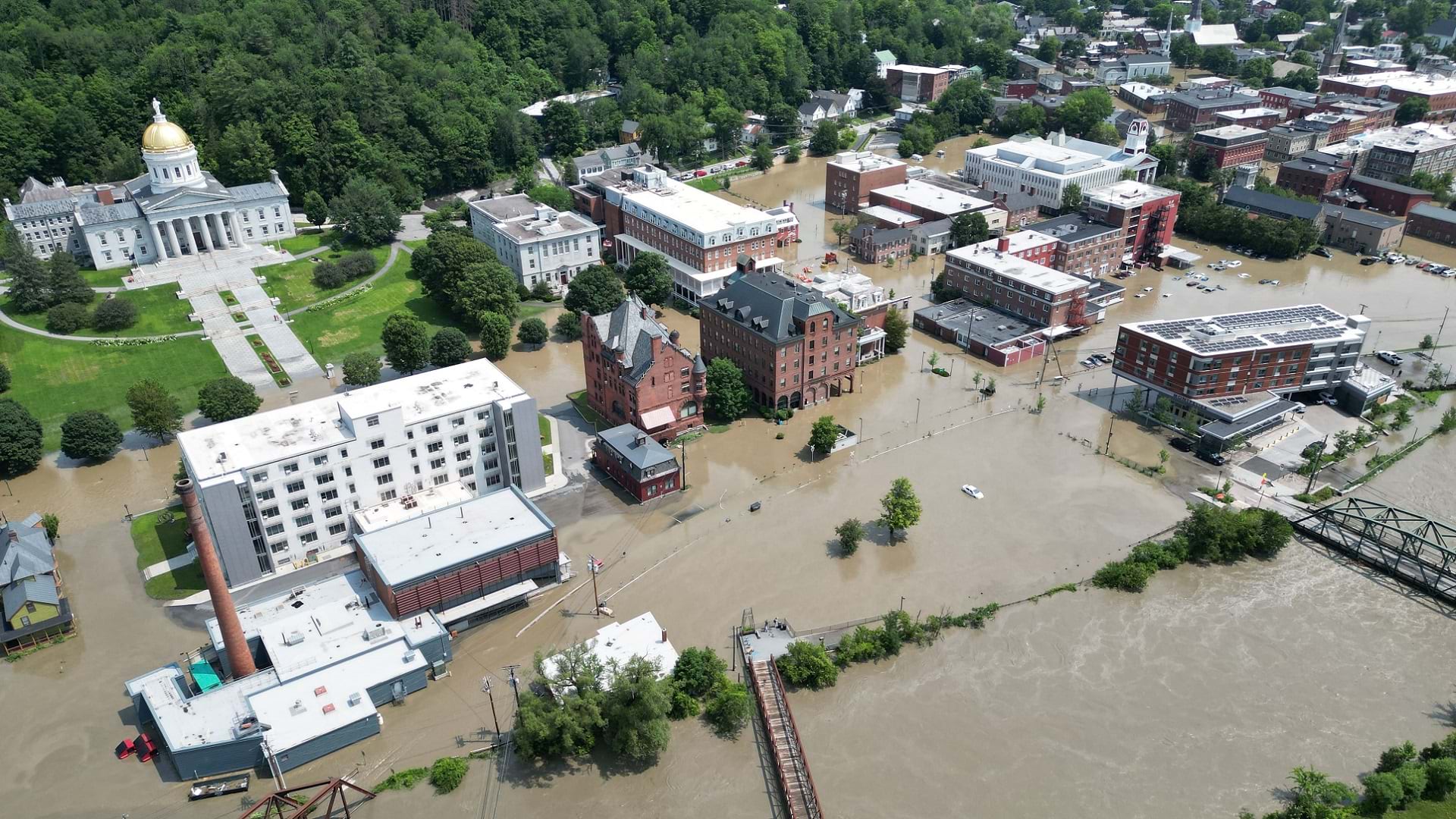During a disaster event, rapid response is critical. For Vermont residents who experienced flooding in July 2023—thanks to GIS and some quick thinking—disaster response meant receiving relief sooner instead of later.
Documenting a disaster’s impact quickly and accurately can speed funding for recovery efforts. In Vermont, a long-standing partnership between state agencies and the state’s largest university led to just the sort of rapid response needed to get resources rolling. Within hours of the floods, there were boots on the ground, unoccupied aircraft systems (UAS) were in the air, and GIS tools—such as ArcGIS Online, ArcGIS Instant Apps (including the Sidebar template), and Site Scan for ArcGIS—were being used to collect and process mapping data and imagery so it could be easily shared.

“We had a limited time to acquire data near peak flood levels, so we knew we had to move quickly,” said Jarlath O’Neil-Dunne, director of the University of Vermont’s Spatial Analysis Laboratory and its UAS team. “The fact that we could play a role in getting Vermonters the recovery money that they need and they deserve sooner is incredibly fulfilling for our mission as the state university.”
Training for Disaster
The Spatial Analysis Laboratory has been on the cutting edge of GIS research for decades. Staffed by 14 full-time employees and more than 60 undergraduate students, it has also quickly become an authority for using drones for mapping.
Depending on the need, five to 15 drone operators in the lab map everything from forest health to stream corridors to gravel pits. The drone team has even been tapped for train derailments, missing-person searches, and homicide investigations.
The team has also carried out congressionally directed research funded by the Federal Aviation Administration since 2020, examining the role of drone technology in disaster response and recovery. This work, carried out through the Federal Aviation Administration’s Alliance for System Safety of UAS through Research Excellence (ASSURE), is helping integrate drone technology for use with emergencies and disasters.
In fact, an environmental disaster ultimately led to the start of the lab’s drone program. During Tropical Storm Irene in 2011, O’Neil-Dunne said, clouds hampered data collection by satellites and piloted aircraft and it was difficult to task staff in a timely manner. O’Neil-Dunne believed that there had to be a better way. The tropical storm also inspired the decade-long effort to further the laboratory’s relationships with state agencies, eventually leading to the successful collaborative response during July’s historic flooding.
“There was such a need 12 years ago for this rapid data collection and dissemination,” said Evan Robinson, the Vermont Agency of Transportation’s UAS program manager, referring to Tropical Storm Irene. The transportation agency has been operating drones for about five years and has partnered with O’Neil-Dunne’s team since the beginning, Robinson said.

Coincidentally—and conveniently—two weeks before the July 2023 storm hit, Esri staff had convened multiple state agencies in the same room with O’Neil-Dunne and his lab team to discuss how to approach collaborating on an emergency situation and various what-if scenarios.
“That really set us up for success,” O’Neil-Dunne said.
Using GIS to Collaborate in the Midst of a Storm
On the morning of July 10, 2023, O’Neil-Dunne was steps away from attending the opening remarks of the Esri User Conference Plenary Session in San Diego when he got a call from Robinson. In an already saturated Vermont, a rainstorm—not even a named storm—was unleashing inches of water that would exceed what Tropical Storm Irene delivered and lead to catastrophic flooding.
Ultimately, “the storm parked there. It just kept pouring,” according to John Adams, director of the Vermont Center for Geographic Information. Satellite imagery wasn’t coming through as quickly, easily, or clearly as the agencies needed. The state needed drone support to document the impact. Robinson and Adams knew they could depend on O’Neil-Dunne’s team of staff and students.
Working from a hotel lobby, O’Neil-Dunne prepared a strategy with his colleagues. Before his red-eye flight touched down back in Vermont, his team was already outside launching drones.
Adams used ArcGIS Online to create a single site—a common operational viewer—within hours of the storm’s start, where the lab’s team and state agencies would contribute and view imagery and geospatial data.
To capture its aerial imagery, the University of Vermont’s drone team worked long hours, sometimes knocking on residents’ doors for permission to launch a drone from a front yard or backyard or venturing into remote areas with limited or no cellphone service in order to find and capture landslide imagery.
The team’s 11 drones took oblique aerial photos to determine high-water marks and for mapping, and the imagery was orthorectified (processed to correct optical distortions from the sensor system) to map the storm’s topographic impact. Lidar-equipped drones helped quantify sediment loss and identify landslides that were under tree cover. In other cases, by using mapping with multispectral sensors, the team could assess crop damage. In the weeks after the flood, the lab acquired satellite imagery from Esri partner Planet Labs, which captures imagery of all the land on Earth each day, to quantify any drop in crop productivity based on data before and after the flood.
The lab initially used ArcGIS Drone2Map as it captured imagery, bringing the results into ArcGIS Pro and then configuring it in ArcGIS Online. At the suggestion of Esri’s Disaster Response Program staff, though, O’Neil-Dunne tried Site Scan for ArcGIS, which reduced the number of clicks required to do even further processing. “That really changed things for us,” he said. Through Site Scan, he could more easily share what his team was capturing—via links, files, and interactive sliders that showed what an area looked like before and after the storm—as well as 2D and 3D views.

“The ease of use of the technology was crucial because we were working 20-hour days,” he said.
As imagery came into the shared site from the Spatial Analysis Lab and state agencies, Adams’s team read metadata, obtained geographic points, and formatted them into a hosted feature layer that could be made available in a web app within hours of the images being captured. The team eventually set up an automated task that would rename photos based on the towns where they were taken. The team also turned the lab’s orthomosaics into cloud-optimized GeoTIFF files containing spatial reference information that could be imported into ArcGIS Pro and preserved in an archive.
Then, without overloading any servers, it was all shared with the Federal Emergency Management Agency in a secure ArcGIS Online group as well as with the emergency operations center and local media via a map viewer app.
O’Neil-Dunne credited his team of students and staff for their confidence under pressure, noting that it was crucial to the mission at hand: getting data to the people who needed it, as quickly as possible.
“Because they have degrees in geography, environmental science, forestry, [and] wildlife biology, they really come at this from understanding that the data products are what’s crucial in these cases,” he said. “The commonality is they’ve all taken GIS courses. In the end, this is about mapping. This is about getting mapping data.”
O’Neil-Dunne hopes that, for future emergencies, every town in Vermont will have drones that can send imagery and data for analysis. He plans to use the July flood response as a case study for a drone training course. “We’re in this together, and what matters most is helping Vermont respond, recover, and rebuild,” he said.

